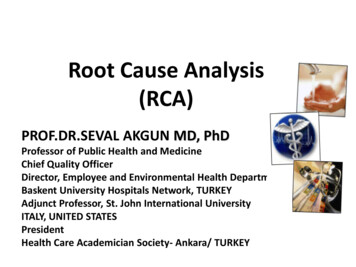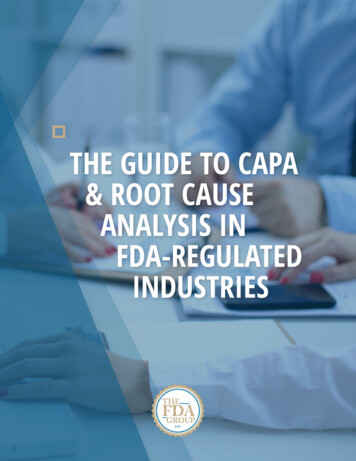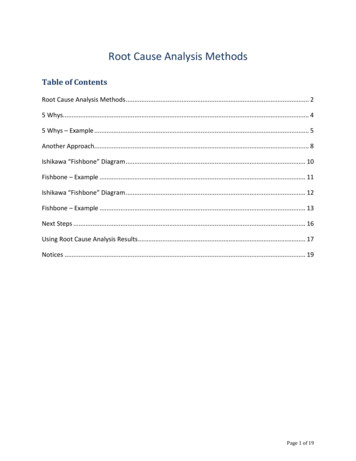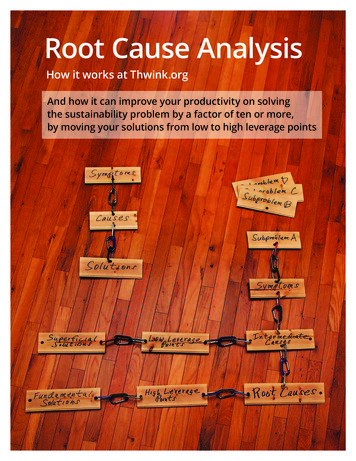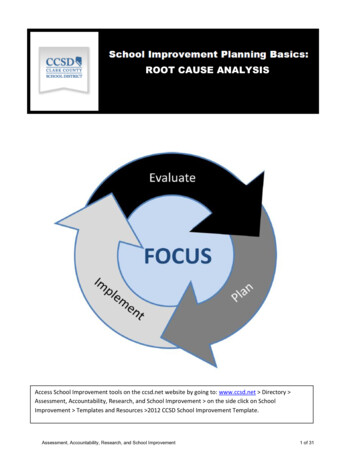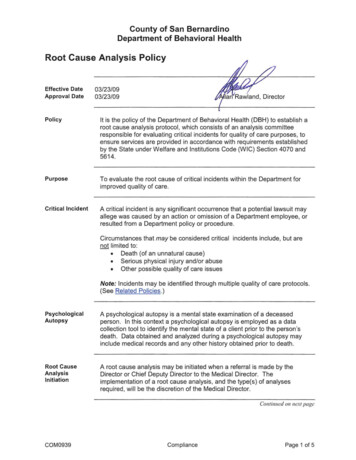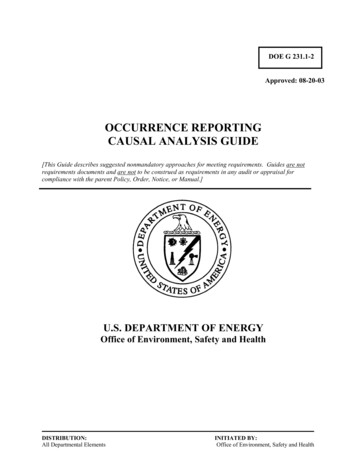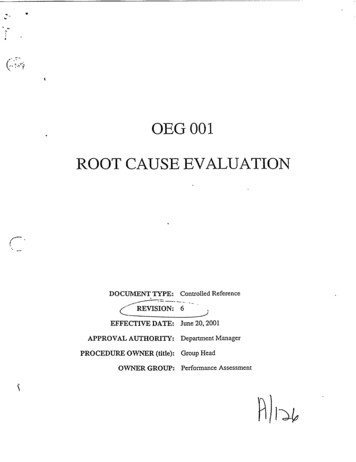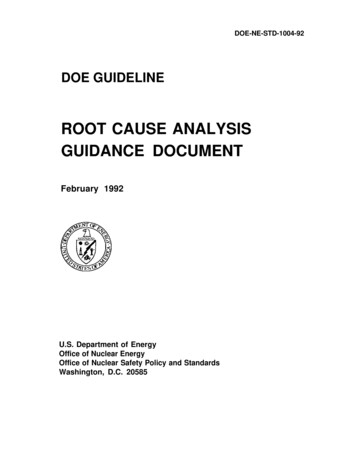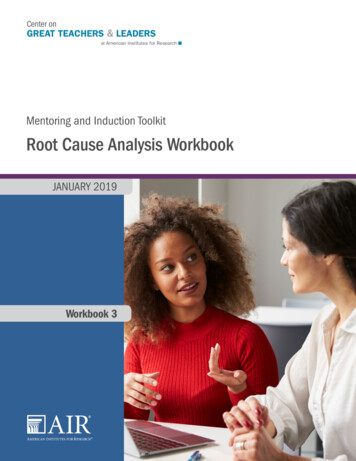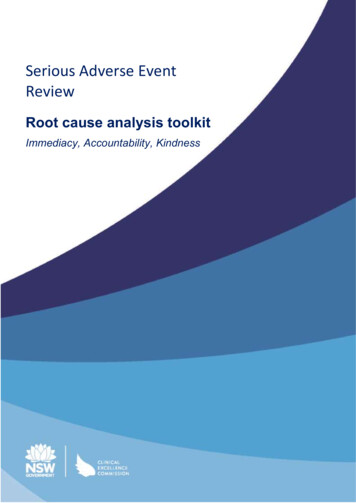
Transcription
Serious Adverse EventReviewRoot cause analysis toolkitImmediacy, Accountability, KindnessDRAFT ACTION PLAN 16TH JUNE 2020 V1 –NOT FOR CIRCULATION
BackgroundEveryday thousands of patients in New South Wales (NSW) are treated safely andcompassionately by highly skilled healthcare professionals. On occasion things go wrongthat result in poor outcomes for patients, carers and their families. When a serious incidentoccurs, action is taken to reduce or prevent or reduce the likelihood of future harm.Serious clinical incidents undergo a serious adverse event review. The Chief Executivedetermines the review methodology for each incident.Regardless of methodology used, an incident review focuses on answering: What happened? Why did it happen? What action can we take to prevent it happening again?Serious adverse event reviews in NSW are underpinned by: Just culture – when an incident occurs, individuals are treated fairly and not heldaccountable for system failings over which they have no control Focus on systems and not people – review processes consider the conditions underwhich individuals work, taking into account the complexity and interdependencies Human factors – action is taken to improve the interaction of staff with one anotherand the environment in which they work Learning – outcomes are shared to generate insights for actionThis toolkit provides guidance for teams undertaking a root cause analysis (RCA) review. Itincludes the tools and processes that will assist a team in answering the three questions.The tools and templates have been adapted from the root cause analysis and action (RCA2)methodology1.The RCA Workbook [link] acts as a compendium to this toolkit and should beused by teams to ensure that all necessary steps have been completed.Page 2 of 34
Table of contentsBackground. 2Serious adverse event reviews . 4Privilege . 5Before the team is appointed . 5Team composition . 6Team appointment. 6Training team members . 6Issues with individual clinicians. 6Root cause analysis . 7Overview RCA process and tools . 8RCA Flow . 9Section one: What happened? . 10Preparation . 10Step 1: Draw a simple flow diagram . 10Step 2: Identify information that needs to be gathered . 11Step 3: Gather information. 13Step 4: Develop a detailed flow diagram. 16Section two: Why did it happen? . 18Step 5: Identify factors that caused or contributed to the incident using a cause and effectdiagram . 18Step 6: Write up factors linking them to outcome . 21Step 7: Identify any practices, process or systems that could be reviewed . 24Step 8: Write Findings Report . 25Section three: What action can we take to prevent it happening again? . 26Step 9: Recommend actions . 26Step 10: Develop action plan . 29Step 11: Write Recommendations Report . 30Acronyms . 4Glossary. 32References . 33Page 3 of 34
AcronymsASECEDFCPRARCARCA2RIBSAERAustralian Sentinel EventChief ExecutiveDedicated family contactPreliminary risk assessmentRoot cause analysisRoot cause analysis and actionReportable incident briefSerious adverse event reviewPage 4 of 34
Serious adverse event reviewsA serious adverse event review (SAER) is required for reportable incidents (clinical HarmScore 1) or clinical incidents that the Chief Executive determines may be due to serioussystemic problems.Approved SAER review methods are outlined in the Health Administration Regulation 2020.The Chief Executive determines the review method for each incident. Root cause analysis (RCA) Systems Analysis of Clinical Incidents – London Protocol Incident Analysis – Canadian Framework Clinical ReviewPrivilegeStatutory privilege applies from the time a SAER team is appointed. It protects teammembers and documents produced as part of the review from use as admissible evidence inany legal proceedings. It does not apply to documents produced previously including theincident report or medical record.SAER team members maintain privilege by not disclosing any information obtained duringthe investigation, unless it is for a purpose that is part of the SAER process.The Incident Management Policy PD2020 047 provides further guidance on privilege.Before the team is appointedWhen a serious incident occurs there are a series of processes that take place prior to thecommencement of a SAER.These include:1) Clinician disclosure – staff share what they know about the incident with the family2) The incident is notified in ims and relevant staff are informed3) A reportable incident brief (RIB) is submitted to the Ministry of Health4) The CE appoints assessors to undertake a preliminary risk assessment (PRA) toguide next steps5) A dedicated family contact (DFC) is assigned. This staff member is the main contactfor the family during the SAER process6) The Open Disclosure team meet with the family to share the PRA advicePage 5 of 34
Team compositionThe Chief Executive (CE) appoints an RCA team composed of 3-5 members: Some have essential knowledge of the care processes where the incident occurred Preferably one member is external to the facility/service One team member (usually team leader) has SAER expertise No team member should have been directly involved in the incident or patient’s careTeam members should not: Have a conflict of interest Be the manager of the department or unit where the incident occurredTeam appointmentTeam members receive a CE letter of appointment and are informed of their roles andresponsibilities.A CE can put a standing appointment in place for certain experienced staff to be coremembers of all SAERs (e.g. DCG, Patient Safety Manager). Once the remaining teammembers are identified, a CE appoints them with reference to the standing appointment.Training team membersRCA team members will come from different backgrounds. Some may have extensiveknowledge and experience in SAER processes. For others, the foundational concepts ofRCA may be totally new.The team leader will have experience and training with RCA. Other team members, requirea basic understanding of RCA process. They are encouraged to access RCA Just in timetraining that is available on the Clinical Excellence Commission Internet Pagehttp://www.cec.health.nsw.gov.au/Issues with individual cliniciansIf the SAER team forms the opinion that an incident may involve professionalmisconduct, unsatisfactory professional conduct or impairment by an individualclinician/s, they must notify the CE in writing. The CE will determine appropriate actionin accordance with PD2018 032 Managing Complaints and Concerns about Clinicianswith support from Human Resources as required.SAER teams can use decision trees to help determine individual versus systemic issuesThe CEC internet page contains a number of tools that the team may wish to rcesThe SAER team take no further action on the matter that relates to the individual.Page 6 of 34
The team may continue to review the systems issues in the incident. This may includeexploring why staff involved in incidents acted as they did, and to pose appropriatequestions to explore the human factors aspects of an incident (e.g. communicationprocesses).Root cause analysisRoot cause analysis (RCA) is a structured method used to review an incident in order toidentify the healthcare systems issues that contributed to patient harm. By understandingthe factors that caused or contributed to an incident, teams can improve patient safety andtake action to prevent future harm2.An effective RCA allows for the design and implementation of a solution that addresses thefailure at its source. It has the following characteristics: Completed by an inter-disciplinary team with involvement of those close to the work Analysis focuses on systems and processes; not individual performance Ensures human factors have been considered Seeks to engage patients, carers and families Drills down to the contributing factors of an incident Identifies actions to make changes to systems and processes that reduce therecurrence of clinical incidents2.RCA is one of the approved methods for a SAER. The CE determines the appropriatereview method for each incident, however in general RCAs are the preferred approach for: Australian Sentinel Events (ASEs)3Page 7 of 34
Overview RCA process and toolsWhat happened?Why did it happen?What action can we take toprevent it happening again?PhaseGather informationProcess / tools usedTrigger questionsFamily and staff interviewsLiterature reviewReview of documents e.g. standards, policiesConstruct a timelineFlowchart diagramsBarrier point identificationIdentify factors that caused orcontributed to the incidentBrainstormingThe five why’sCause and effect diagramsLink factors to the outcomeCausation statement worksheet5 rules of causationMake recommendationsAction hierarchy worksheetRCA Action Planning worksheetTimeline for completion of review: 60 daysWhat happned? Within 5-6 weeksWhy did it happen? Within 6-7 weeksWhat action can wetake to prevent ithappening again? Complete within 7-8weeksPage 8 of 34
RCA FlowThe following flow is recommended for RCA review. The flow and process may vary depending on the complexity ofthe incident under review.Before the first meetingThe medical record and any other relevant documentation are reviewed by the teamMeeting 11. A simple flow diagram is constructed.2. Checklist questions are applied to identify questions that need to be answered.3. How, what and why questions are used to determine the information to be collected through speaking withpeople, gathering relevant documents and looking at the literature when applicable.After the first meetingRelevant information is gathered through meetings with patients, carers and families, staff interviews and thecollation and review of documents and literatureMeeting 21. The information gathered is reviewed and used to construct the final flow diagram2. At each point in the flow diagram, the team ask ‘so what’ or ‘what is the relevance’ of each box in theincident chain.3. The team identify whether barriers at each step might stop the problem from occurring again.4. The team agree on the most significant issues outlined in the final flow diagram and use these for the causeand effect diagram.5. They continue to ask ‘why’ or ‘caused by’ at each box on the tree until there are no more answers. Theseare the contributing factors.6. The team define any practices, processes or systems that could be reviewedAfter the second meetingThe Findings Report is written and is shared with the family following CE approval. Additional experts are appointedto the team to assist with developing recommendations if indicatedMeeting 31. Factors that caused or contributed to the incident are linked to outcomes”.2. Actions and recommendations and key outcome measures are writtenAfter the third meetingThe Recommendations Report is finalised and submitted to the CE for approval. The approved report is submittedto the Ministry of Health and shared with the family.Page 9 of 34
Section one: What happened?For an: RCA team to understand what happened they:Step 1:Construct a simple flow diagramStep 2:Identify information that needs to be gatheredStep 3:Gather informationStep 4:Develop a detailed flow diagramPreparationThe team leader provides team members with access to the incident report, medical record,preliminary risk assessment (PRA) and any other relevant documentation to review prior tothe first meeting.Step 1: Draw a simple flow diagramAt the first meeting, the team develop a shared understanding of the event by constructing asimple flow chart. This outlines the chronology of the incident from the first known factthrough to the final event (incident under review).InstructionsI.II.Presented toED withatypical chestpainUsing post-it notes construct an initial flow diagram of 5 to 6 boxes outliningthe chronology of events that led to the incident.Hint: Sometimes it is easier to start at the end and work backwards.Patientreviewed byRegistrarThe Registrarordered testsDischarged bydifferentmedical officerPatientarrested incar parkPatientreadmitted incardiac arrestPage 10 of 34
Step 2: Identify information that needs to be gatheredThe team review each flow chart box and ask what is and isn’t known about whathappened before, during and after each point. What additional information would theteam like to find out? The team determine who can help them and distribute tasksfor completion before the next meetingInstructionsI.Brainstorm as a group the key questions or things you would like to know about thesequence of events. The RCA Triggering Questions (see RCA workbook for teams)will lead teams to appropriate questions for consideration.II.Work through each box to identify questions outlining what isn’t known. Write outquestions and phrase in terms of how, what and why under each box of the initialflow diagram.III.Identify who you need to interview and who on the is going to do the interviews.IV.Identify what additional information you need and who is going to collect it e.g.literature, standards, policies, rosters.Page 11 of 34
How, whatand why?How, whatand why?How, whatand why?How, whatand why?How, whatand why?How, whatand why?The Registrarordered testsDischarged bydifferent medicalofficePatientarrested in carparkWhatassessmentwas performed?What tests wereordered?What follow uparrangementswere made forthe patient?What was thepatient’scondition ondeparture?What was thepatient’scondition onreadmission?What riskfactors werepresent?What did hethink of thepatient riskfactors?What are theprocesses forordering andfollowing uptests?What handoveroccurred?Did the patientdevelop morepain on exit?Whatconversation didthe team havewith thepatient’s wife?Was the patientput on the chestpain pathway?Howexperienced isthe registrar?How was thepatient triaged?Whatinformation wascommunicatedbetween himand otherclinicians?Presented to EDwith atypicalchest painPatientreviewed byRegistrarWhy did thepatient sit in thewaiting roomWas the patientand/or wife toldwhat theinvestigationplan was?What is theusual dischargepractice?Were normalprocesses forassessment andreview of chestpain followed?Patientreadmitted incardiac arrestWhat did thepatient’s wifethink of hiscondition ondischarge?Were theyhappy to leave?Page 12 of 34
Step 3: Gather informationThe RCA team collects information using a number of methods which may include: Walking through or observing areas involved in the incident Reviewing medical records Examining equipment Researching recommended practices Interviewing patients, carers and families Interviewing staffInterviewing patients, carers and familiesPatients, carers and family members should always be invited to meet with the RCA team.The dedicated family contact will initiate the offer and advise the team leader if the family arewilling to meet with the review team.If the family are not comfortable with a formal interview, they should be supported to provideinput in other ways e.g. written statements.Interviewing staffRCA team members meet with a variety of staff members to compile a system level view.Staff who are interviewed should be provided with a letter explaining their legal rights andresponsibilities.Being interviewed about a serious incident can be anxiety provoking for staff. To activelyparticipate in discussions, they need to feel safe. By displaying empathy and focusing onlearning to improve systems of care, the RCA team member /s establish psychologicalsafety.Page 13 of 34
Establish rapport Explain RCA process and purpose of interviewBeginningMiddleEnd Use open ended question to initiate a recount Prompt for further information Use active listening – summarise what has been recounted Use empathy Thank staff member and explain how information will be used Advise that follow up interview may be needed Explain when and how report feedback will be provided Check on well being of staff member and offer support if neededSetting up meetings Meetings should be conducted as soon as practical. A person’s memory of the event willfade with each passing day. Staff being interviewed are sent a letter explaining that the conversation is privileged.This means that the interviewer must maintain confidentiality and any of the notes takenare not admissible in any court proceedings. If possible, peers should be used to interview staff e.g. a nurses interview nurses, alliedhealth interview allied health staff Meetings are ideally conducted in person. Telephone interviews may be appropriatewhen the individuals know and trust each other. Where possible, two RCA team members attend each meeting. This enables one personto facilitate the discussion while the other records the conversation. Meetings should take place at a mutually convenient time in a venue free fromdistraction. The RCA team member/s prepare for the session by bringing RCA team queries andpreparing some open-ended questions. The staff member may bring a support person if they wish.Conducting meetingsThe RCA team member opens the session by explaining the RCA process and the purposeof the meeting. The focus on systems issues to prevent recurrence is stressed. Concernsand issues are discussed to allay anxieties.Page 14 of 34
The interviewer seeks permission from the individual to take notes throughout thediscussion.Effective questioning makes fact finding easier and the individual more comfortable with theprocess. Open-ended questions are used to elicit a factual recount of the event. Thediscussion begins with broad questions and then moves to specific clarifying questions. Thestaff member is encouraged to limit their comments to what they observed and avoidconjecture.The RCA team member asks the staff member what they believe were the contributingfactors to the incident. The staff member should be also asked to make suggestions aboutwhat could be put in place to prevent a similar incident happening in the future.The RCA team member conveys empathy and uses reflective listening to check that that thestory is being understood.The RCA team member should not disclose who else will be interviewed or what others havealready said.The interview is closed with an expression of thanks, ensuring the interviewee has had anopportunity to ask any questions about the SAER process. The individual is advised ofwhen the final report is due and how they will receive feedback.The staff member is provided with the details of the designated RCA team member tocontact if they think of any additional information. They are also advised that a follow updiscussion may be required if new information is discovered in other interviews from theinvestigation.This can be a highly emotive process for staff. A welfare check is completed to determine ifthe individual requires any follow up support.Gaining insights and ideas from patients, carers and familiesPatients, carers and families provide a unique perspective to the review process. Theyshould be invited to meet with the RCA team.In general the same principles are followed for setting up and conducting interviews withstaff. Some additional considerations include: Always have at least two RCA team members meet with the family. This will supportaccurate information gathering. Coming back to the health service where the incident took place may be challenging.The family should specify their preferred location. An expression of apology should be provided and an acknowledgement of distress. The family may have questions for RCA team members. These should be noted andfollowed up at another time as appropriate.Page 15 of 34
The patient, carer and family should be advised that they will be provided with feedbackat an open disclosure event after the final report is completed. An approximate dateshould be provided. Accessibility requirements need to be factored in when planning for meetings. Communication approach may need to be adapted to accommodate health literacylevels. The cultural needs of the family should be assessed and support services arranged ifappropriate e.g. Aboriginal Liaison Officer, healthcare interpreterIf the family are not comfortable with a formal meeting, they should be supported to provideinput in other ways e.g. written feedback.Step 4: Develop a detailed flow diagramOnce all the information has been gathered, the team can construct a final flow diagram.The provides a detailed chronology of factors leading to the event. At each point the teamshould ask ‘what is the relevance?’ of each piece of information. Could what happened /didnot happen have contributed to that part of the sequence of events. The team should thenidentify where barriers may be put in place to prevent the problem occurring again.InstructionsI.Each piece of information gathered is written on a post-it note.II.Post-it notes are moved around until all the information forms a detailed final flowdiagram of everything that happened. This provides a detailed chronology of eventsIII.At each box of the final flow diagram ask where, if things were changed, would theincident have been prevented from occurring – i.e. where could things be improved this could be done by asking ‘so what?’ or ‘what is the relevance of each piece ofinformation?’.IV.These barrier points in the final flow diagram are where there are holes in the “Swisscheese” and if an intervention were made at these points, the problem may not haveoccurred – place a red bar at each of these points; these will translate into yourprimary causes.Page 16 of 34
Detailed flow diagramPatientpresented to EDwith atypicalchest painPatient offershistory of riskfactors and comorbiditiesTriaged bynurse new tothe positionSo what?Nurseinexperienced &lackedknowledge ofWife describespain is differentfrom ulcer painSo What?- nostandardisedchecklist forhistory takingSo What?- noguidelines formgt of atypicalchest pain andinexperiencedguidelinesConsultation isdisrupted byphone callReviewed byRegistrar whotells nurse heneeds ECGSo what?- Patientassessment interrupted,no clerical support forphone callsRegistrarcompletesexaminationTaken intocubicle bydifferent nurseand baselineSo What?- noculture thatinvolves pt &family in historytakingDirected to sit inthe waitingroomnurse ontriageobs takenSo What?- no formalmechanism for requestinginvestigations or toensure test are doneRegistrar givenECG by a thirdnurseSo What?- nostandardised checklistto ensure issuesrelating to atypicalchest pain consideredSo What?- no clearidentification of ptdetails on test results,disrupted care frommultiple providersSuccessfulresuscitationBrought intoresuscitationbayRegistrar handsoverresponsibility fordischarge toJMOPt dischargedby JMO withletter to GPSo What?- noprocess toensure that alltests had beencompletedSo What?- no structuredhandover to convey thenecessary informationWife notifiedsecurity guardwho alerts EDstaffPt has cardiacarrest in carparkPage 17 of 34
Section two: Why did it happen?For an RCA team to understand why an incident happened they:Step 5: Identify any factors that caused or contributed to the incident using a cause andeffect diagramStep 6:Write up factors linking them to the outcome (“causation statements”)Step 7:Identify any practices, processes or systems that could be reviewedStep 8:Write findings reportStep 5: Identify factors that caused or contributed to the incidentusing a cause and effect diagramThe cause and effect diagram assists in analysing the relationships between a problem andits causes. It is a systematic way of combining the previous brainstorming, informationgathering and flowcharting tasks.The cause and effect diagram: Describes the problem for which causes need to be identified Ensures the team questions each cause to the form of error chains and identify thecontributing factorsIdentifies the primary causes that directly preceded the problem. Primary causes canbe described as either:o Action – event or action that happened at a point in timeo Inaction -something that didn’t happeno Condition – exists over time, may relate to systems, processes or cultureInstructionsI.Define the problem that you are trying to eliminate in one sentence.II.Document the barrier points which have were identified in the final flow diagram aseither an action, inaction or condition in the cause and effect diagram.III.For each primary cause, a series of why questions or caused by questions are askeduntil no further information is available – this will become the contributing factor.Repeatedly asking the question “why?” allows for the layers of an issue to beexamined leading to the root cause of a problem.IV.Continue the above for each primary cause – remember these are not linear trees.V.Check each causal chain by: Moving from the problem statement to the contributing factors and asking at eachstep – was this directly caused by.?Page 18 of 34
Moving from the contributing factor up to the problem statement and asking ateach step – did this result in or lead to ?Page 19 of 34
Cause and effect diagramECG not completedRegistrar instructedJMO to refer to GPPatient dischargedwith undiagnosedmyocardial ischaemiaJMO did not reviewtest resultsWrong ECG reviewedRegistrar wasdistractedAssumed test werereviewed by RegistrarRequest notdocumented inmanagement planRegistrar didn’t verifypatient detailsGot called away tosee other patientsNo supervision ofJMO during dischargeprocessAssumed that tellingnurse would mean testwould be ordered as thishas worked in the pastAssumed it was theECG he requestedBusy workloadNo structured processfor ordering testsNo formal mechanism toverify resultsNo clear process forbackfill of sick leaveLack of mechanism toverify results havebeen checked prior todischargePage 20 of 34
Step 6: Write up factors linking them to outcomeThe team link the identified factors to the outcome to clearly define why something occurred.Factors focus on processes and systems, not individuals.Examples of factors linked to outcome#Linking factors to outcome1Informal handover practices led to the wrong patient being discharged2Processes for test ordering led to an ECG not being completed resulting inundiagnosed myocardial ischaemia3Inconsistent review processes for reviewing test results led to clinical decisionsbased on the ECG results of another patient4Rostering practices of senior medical staff did not take into account collegeexamination periodsAlternately, causation statements can be used to link factors to outcomes. A Director ClinicalGovernance may state a preference for this approach.A causation statement links the causes identified to the effects and then back to the eventthat prompted the RCA . It is written in unambiguous terms, easily understood bystakeholders who are not part of the RCA team.A causation statement has three parts:The cause: “This happened ”The effect: “ which led to something else happening ”The event: “ which caused this undesirable outcome.”Page 21 of 34
Examples of causation statements#Causation statements1There were no procedures established or expectations regarding formal handover ofidentification of patient, thereby increasing the chance that patient’s would bemisidentified. This resulted in the patient being discharged and without full reviewwith undiagno
Root cause analysis Root cause analysis (RCA) is a structured method used to review an incident in order to identify the healthcare systems issues that contributed to patient harm. By understanding the factors that caused or contributed to an incident, teams can improv

